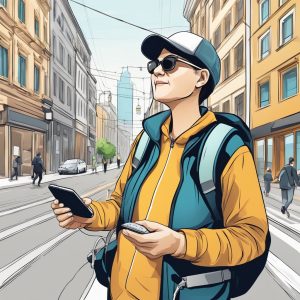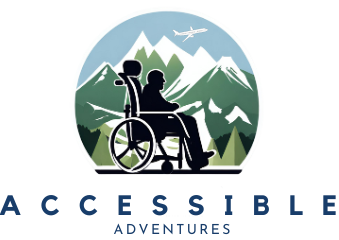GPS Devices for Visually Impaired Travelers: Navigating the World with Confidence

GPS devices have revolutionized the way we navigate and travel, and this technology has been especially beneficial for visually impaired travelers. These devices have made it easier for individuals with visual impairments to travel independently and with confidence. In this article, we will explore the different GPS devices available for visually impaired travelers and how they can enhance mobility and independence.
Understanding GPS technology for the visually impaired is essential to comprehend how these devices work. GPS stands for Global Positioning System, which is a network of satellites that orbit the earth. These satellites transmit signals to GPS receivers, which then calculate the user’s location. GPS devices for visually impaired travelers use this technology to provide audio cues and directions to help them navigate their surroundings.
Key Takeaways
- GPS devices have made it easier for visually impaired travelers to travel independently and with confidence.
- GPS technology uses a network of satellites to provide audio cues and directions to help visually impaired travelers navigate their surroundings.
- Indoor navigation solutions are becoming increasingly popular and are the future of navigation for visually impaired travelers.
Understanding GPS Technology for the Visually Impaired
If you are visually impaired, GPS technology can be a useful tool to help you navigate through the world with greater independence. GPS, or Global Positioning System, is a network of satellites that transmit signals to GPS devices or apps. These signals can be used to determine your location, speed, and direction of travel.
How GPS Works for Blind Travelers
GPS devices and apps for the visually impaired use voice output and touch input to provide users with information about their surroundings. Voice output is used to announce street names, landmarks, and other points of interest. Touch input allows users to interact with the device or app by tapping, swiping, or using other gestures.
Types of GPS Devices and Apps
There are several GPS devices and apps available for visually impaired travelers. Some popular examples include BlindSquare, Seeing Eye GPS, Nearby Explorer, Lazarillo, and Ariadne GPS. These apps are available for both iOS and Android smartphones, including the iPhone.
Key Features of Accessible GPS Devices
Accessible GPS devices and apps are designed with the needs of visually impaired users in mind. They typically feature large, high-contrast text and simple, intuitive navigation menus. They also include voice output and touch input for easy interaction. Some GPS devices and apps also offer additional features such as real-time traffic updates, public transportation schedules, and the ability to save and share favorite locations.
In summary, GPS technology can be a valuable tool for visually impaired travelers. With voice output, touch input, and other accessible features, GPS devices and apps can help you navigate through the world with greater ease and independence.
Indoor Navigation Solutions
Indoor navigation can be challenging for visually impaired travelers. Unlike outdoor navigation, indoor navigation requires a different set of tools and technologies. In this section, we will discuss the challenges of indoor wayfinding, technologies enabling indoor navigation, and popular indoor navigation systems.
Challenges of Indoor Wayfinding
Indoor wayfinding is a complex process that requires a combination of technologies and tools. Some of the challenges of indoor wayfinding include the lack of GPS signals, the presence of obstacles, and the need for real-time updates.
Technologies Enabling Indoor Navigation
Several technologies enable indoor navigation, including Bluetooth beacons, Wi-Fi access points, infrared, sensors, computer vision, and inertial measurement units (IMUs). Bluetooth beacons and Wi-Fi access points are two of the most popular technologies for indoor navigation. Bluetooth beacons are small devices that transmit signals that can be used to determine a user’s location. Wi-Fi access points use Wi-Fi signals to determine a user’s location.
Popular Indoor Navigation Systems
Several indoor navigation systems are available for visually impaired travelers. Some of the most popular systems include Roshni, BlindSquare, and Nearby Explorer. Roshni is an application that uses voice messages to guide visually impaired users. BlindSquare is a navigation app that provides information about the user’s surroundings. Nearby Explorer is an app that provides information about nearby points of interest.
In conclusion, indoor navigation can be challenging for visually impaired travelers. However, several technologies and tools can be used to enable indoor navigation. Popular indoor navigation systems include Roshni, BlindSquare, and Nearby Explorer.
Enhancing Mobility and Independence
GPS devices have become an indispensable tool for visually impaired travelers, enabling them to navigate unfamiliar environments with greater ease and confidence. Here are some ways GPS devices can enhance your mobility and independence:
Tools for Daily Travel and Exploration
GPS devices can help you navigate to your desired destination, whether you are walking or using public transportation. Many GPS devices also offer turn-by-turn directions, which can be especially helpful when exploring new areas. You can also use GPS devices to find nearby landmarks and points of interest, such as restaurants, shops, and museums, making it easier to plan your daily activities.
Safety and Accessibility Features
GPS devices can also help you stay safe while traveling. Many devices offer audible alerts when you approach hazards such as busy intersections or construction zones. Some devices also offer features such as tactile feedback or voice commands, which can be helpful for users with limited vision or dexterity.
Integrating GPS with Other Assistive Technologies
GPS devices can be integrated with other assistive technologies, such as wearable devices or electronic travel aids, to provide a more comprehensive navigation experience. For example, some GPS devices can be paired with object recognition software, which can help you identify and avoid obstacles in your path. GPS devices can also be used in conjunction with mobility training and independent living skills to help you develop greater confidence and self-sufficiency.
In conclusion, GPS devices offer a range of features and benefits that can help visually impaired travelers navigate their environments more safely and confidently. Whether you are walking, using public transportation, or exploring new areas, a GPS device can be an invaluable tool for enhancing your mobility and independence.
The Future of Navigation for the Visually Impaired
As technology continues to advance, the future of navigation for the visually impaired looks bright. Emerging technologies and innovations are making it easier for individuals with visual impairments to navigate their surroundings with greater ease and independence.
Emerging Technologies and Innovations
Augmented Reality Libraries, Deep Learning, Sonification, Video Games, and Navigation Technologies are some of the emerging technologies that are being developed to enhance navigation for visually impaired travelers. Augmented Reality Libraries allow users to access location-specific information through their smartphones. Deep Learning is being used to improve object recognition, while sonification is being used to create audio representations of visual information. Video games are being developed to provide a more immersive experience for users, while navigation technologies such as RFIDs, Magnetic Signatures, and Inertial Sensing are being used to provide more accurate and reliable navigation information.
Research and Development Trends
Research and development trends in the field of navigation for the visually impaired are focused on improving the accuracy and reliability of existing technologies, as well as developing new technologies that can provide more comprehensive navigation assistance. Systematic reviews of existing technologies are being conducted to identify areas for improvement, while new technologies are being developed through collaboration between researchers and individuals with visual impairments.
The Role of Community and Feedback
The role of community and feedback is critical in the development of navigation technologies for the visually impaired. User feedback is essential in identifying areas for improvement, while community support is necessary to ensure that new technologies are accessible and relevant to the needs of visually impaired travelers. As new technologies continue to emerge, it is important for developers to work closely with individuals with visual impairments to ensure that their needs are being met.
In conclusion, the future of navigation for the visually impaired is bright, with emerging technologies and innovations providing new opportunities for greater independence and mobility. Through ongoing research and development, as well as collaboration with the visually impaired community, we can continue to improve the accuracy and reliability of navigation technologies, and provide individuals with visual impairments with the tools they need to navigate their surroundings with confidence and ease.
Frequently Asked Questions
What are the top-rated GPS navigation systems designed for visually impaired individuals?
There are several GPS navigation systems specifically designed for visually impaired individuals. One of the top-rated GPS devices is the Trekker Breeze Handheld Talking GPS from HumanWare. This device has a simple interface and provides turn-by-turn directions using voice commands. Another popular GPS navigation system is the Victor Reader Trek, which combines GPS navigation with a digital book player.
How do visually impaired travelers benefit from using GPS devices?
GPS devices provide visually impaired travelers with greater independence and mobility. With GPS devices, travelers can navigate unfamiliar environments with greater ease and confidence. GPS devices can also provide important information about nearby landmarks, businesses, and other points of interest.
What are some free GPS navigation solutions available for the visually impaired?
There are several free GPS navigation solutions available for visually impaired travelers. One such solution is BlindSquare, a GPS app that provides audio directions and information about nearby points of interest. Another free GPS navigation solution is Ariadne GPS, which provides audio feedback and turn-by-turn directions.
Can you recommend any mobile apps that assist with indoor navigation for the blind?
Yes, there are several mobile apps that assist with indoor navigation for the blind. One such app is BlindSquare Event, which provides audio directions and information about indoor events and venues. Another app is Nearby Explorer Online, which provides indoor navigation assistance in select cities.
Are there any GPS applications specifically tailored for visually impaired users in India?
Yes, there are GPS applications specifically tailored for visually impaired users in India. One such app is the Eye-D app, which provides audio directions and information about nearby points of interest. Another app is the Braj Smart Guide app, which provides audio directions and information about landmarks and tourist attractions in the Braj region of India.
How does BlindSquare and Ariadne GPS enhance outdoor navigation for blind travelers?
BlindSquare and Ariadne GPS enhance outdoor navigation for blind travelers by providing audio feedback and turn-by-turn directions. These apps also provide information about nearby points of interest, such as businesses, landmarks, and other attractions. By using these apps, travelers can navigate unfamiliar environments with greater ease and confidence.
